You are reading the older HTML site
Positive Feedback ISSUE
15
september/october 2004
cardas
Cross and Golden Cross cables
as reviewed by Jeff Parks
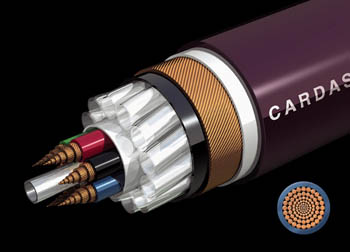
|
JEFF PARKS' SYSTEM
LOUDSPEAKERS
ELECTRONICS
SOURCES
CABLES
ACCESSORIES
|
The Search for the Perfect Cable
Cables, the final frontier. These are the voyages of the audiophile seeking aural nirvana, to seek out new cable possibilities, to boldly go where one is often reluctant to go.
All right, that may be a little hokey, but I think you get my point. All too often, we fail to seek out the right cables for our systems. There are many reasons for this. One is that after spending thousands of dollars on amplifiers, speakers, etc., many of us simply run out of money for cables. I must confess that I, like many audiophiles, get caught up in the excitement of buying hardware, but when it is time to think about final touches like stands, cartridges, and cables, I put them on the back burner.
In order to stay happily married (and to avoid a placing a second mortgage on my home), I often take money from my accessory budget to purchase that special system upgrade. Maybe that is why, as my system's hardware has improved, I continue to put off looking into new cables, despite the fact that I do not think of cables as accessories or afterthoughts, but critical components. If you make your next cable purchase wisely, you will be rewarded with a system that achieves its full potential, and get closer to the aural bliss we all want to obtain from our systems.
Knowing that cables are important to the success or failure of a system, the question arises: How much should we spend on them? The answer, in short, is to spend what you need to spend to accomplish your goals. Are you looking for cable that is revealing and articulate, or musical and forgiving? This depends upon your needs and the sonic signature of your rig. I try to find cable that has the least additive or subtractive effect, while being both as musical and as close to the original recording as possible. Yes, I want it all. Is this possible? I think so. You just have to be patient. Eventually you will find the cable that matches your system.
To return to the question of cost, I stick to my recommendation that you should only spend as much on cables as you need to accomplish your goals. Most industry experts agree that audiophiles should spend between 10 and 15% of the total retail cost of the system on cables in order to match their quality with that of the gear. Remember that this is only a guideline. It is possible to find satisfying cables that cost much less, and also to spend much more.
Aside from the issue of staying within budget, isn't wire just wire? According to George Cardas, "No!" Bearing in mind that Cardas has been in the business of making audio and video cables for over 25 years, it makes sense that he believes that wire is NOT just wire. He states, "In reality, high end cables must balance resistance, capacitance, inductance, conductance, velocity of propagation, RF radiation and absorption, mechanical resonance, strand interaction, hysteresis, high filtering, wavy serial impedance and reflections, electrical resonance, dissipation factors, envelope delay, phase distortion, harmonic distortion, piezoelectric effects, structural return loss, skin effect, corrosion, cross talk, bridge-tap and the interaction of these and a hundred other things." What a mouthful! Although many of us understand some of these points, we leave the technical stuff to the designers. What really matters is how a cable sounds in our system.
Once we understand that cables are very important pieces of the puzzle, what then? Reviews can give an indication of the performance of a cable, and I recommend starting there. (Okay, I am a bit biased.) After reading reviews and consulting your audiophile buddies, discuss your needs with a trusted audio salon and take home any cable that interests you. That, in my opinion, is the best idea. Most audio dealers—at least those who have the interests of their clients at heart—will allow you to take cables home. The bottom line is how the cable sounds in your system, not the retailer's or the reviewer's. Make sure the cables are fully broken in (50 to 400 hours depending upon the cable's material and geometry). Most dealers will loan broken-in demo cables to customers. In some cases, they will go as far as to allow them up to 30 days to decide if the cable is right for them.
In my never-ending search for the perfect cable (if such a beast exists), I am going to do a series of cable reports over the next year. Although my goal with each report is to get at the heart of the sound of a particular cable, the results will be affected by my personal tastes and by the way in which the cable links up with the rest of my system. Bearing in mind that everyone hears things differently, using different systems, ears, and tastes in music, I have requested that Dave Clark keep me unaware of other reviewers' opinions, and vice versa. This way, we cannot influence each other, promoting more accurate reports.
In order to limit other confounding variables, I will only examine complete lines of cabling throughout my system. I will listen to interconnects in both XLR and RCA terminations whenever possible. To accommodate most readers' needs and listening conditions, I will request two different sets of cables from each manufacturer, one being their best, and presumably most revealing cables, and the other being their most musical and forgiving (which may be their best as well).
I decided to begin my series of reviews with the Cardas Golden Cross speaker cables and interconnects. I chose these because of George Cardas' status as an industry leader, whose company has stood the test of time. I have also used Cardas Cross cables—the ones below the Golden Cross in the Cardas line—for the past five years. Until recently, the Golden Cross cables were the top of the Cardas line, but with the addition of the Golden Reference (the subject of my next report), the company offers two top-of-the-line cables, each with their own sonic signature (or lack thereof).
The Golden Cross cables use Cardas' patented Golden Section Stranding, a design based upon the Golden Ratio of 1.16180339887… to 1, a mathematical proportion that nature uses to shape leaves, seashells, insects, animals, and people. It also is the ratio of hurricanes, galaxies, and is at the heart of many musical scales and chords. In short, the Golden Ratio is a large part of human existence. It was discovered by the Greeks, and has been used for centuries to create great works of art and architecture. A classic example is the Great Pyramids of Egypt. Perhaps it is the use of the Golden Ratio in the design of Cardas products that gives them their unique sonic signature, one of great resolution and musicality.
A major concern in designing audio cable is resonance. If you strike a guitar string and hear the other strings play along in sympathy, that is resonance—a bad thing when it happens in cables. When a signal is conducted through a cable with more than one strand of wire, each strand causes the other strands to vibrate and ring. When two or more strands have the same mass and tension, they will have a common resonance point, and each will cause the others to sympathetically vibrate. This will result in a new point of interaction, creating a different frequency that in turn will resonate with the other strands, repeating over and over until all of the strands of wire are affected. This results in a smearing and coloration of the sound, or worse, peaks and valleys in the cable's frequency response, causing very uneven sound. Cardas' Golden Section Stranding solves this problem.

In Golden Section Stranding (above), the individual strands of wire share no common mathematical code or resonant point, thus absorbing or canceling the noise they create. Cardas cables enjoy a very low "Q," or resonant point, compared to conventional conductors, resulting in a very silent cable that is able to produce the purest possible audio signal. It is this silence that gives Cardas cables the reputation of being so pure and musical. Another factor in the design of Cardas cables is the use of Constant Q Stranding. The wire is stranded using a proprietary method by which the strands diminish in size toward the center of the conductor. This allows each strand to share the load equally, reducing the internal rise in inductance seen in most conductors without compromising the symmetry or capacitance of the cable.
Cardas also uses Crossfield Construction to prevent RFI/EMI signals from interacting with the cables. All wires have a tendency to radiate and absorb RFI/EMI signals. Crossfield Construction prevents this by reversing every other stranded layer of wire at a 90-degree angle in order to reduce the dipole effect. Think of Crossfield Construction as a method of braiding wire in bundles, much like braiding hair.
Few cable manufacturers draw their own copper, and neither does Cardas, but the copper is drawn in a proprietary manner, using a diamond die in an atmosphere of pure nitrogen. This results in the purest copper available. Once the copper is drawn, Cardas uses an enamel protective coating that insulates the wire from interacting with elements outside its original pure nitrogen environment. This prevents corrosion and increases longevity.
During every step in the manufacturing process, Cardas maintains the purity of the copper until it is sealed during termination. Cardas also uses pure Teflon and air dielectrics, ultra-pure quad eutectic solder, and custom rhodium-plated connectors, again to prevent corrosion. All of these time-consuming procedures, materials, and design philosophies promote the notion that Cardas cables should last a lifetime, something that Cardas representative Brian VonBork told me when I visited the Cardas factory last July.
How do these cables sound? They went through an extensive break-in period of well over 400 hours before serious listening. With less than 100 hours, the cables sound a little unbalanced, discontinuous, and dry. After 100 hours, things change dramatically. The cables begin to come into their own, and what was once unbalanced and discontinuous is now clear and concise, with a much more defined soundspace. At 400 hours, the cables have the best balance between detail and air.
The first words that came to my mind when I listened to the Golden Cross cables were "balance" and "musicality." I was utterly amazed at the sonic differences between these cables and my Cross cables. The Cross costs about $433 per meter, whereas the Golden Cross are $900 per meter. Is the improvement in sonic purity and enjoyment worth the near doubling of cost? Let's find out. The Cross cables are a little forward—not necessarily a bad thing. While clear and concise in the upper ranges, the Cross cables are not as smooth as the Golden Cross cables, which have more detail and air. The upper reaches seem to go on forever. Not once did the Golden Crosses sound tipped, etched, or bright. This is not to say that the Crosses sounded etched or bright, although it could happen if the recording was etched or bright.
The best way I can describe the difference between the Cross and the Golden Cross cables is to use an upsampling analogy. Upsampling is the D-to-A converter's ability to sample the signal many more times than the standard 44.1K times per second. For example, a converter that upsamples to 192K times per second, and which increases the word length to 24 bits to accommodate the larger amount of data, can link more dots of digital information within each second. It is this larger number of "dots" that gives upsampling DACs their improved sound. Using the example of cymbal crashes, with the Cross cables, the attack and decay is there, along with the ringing of the cymbal being hit. With the Golden Cross, the sound is more refined and detailed, with a bloom that gives a feeling of great warmth and richness. You hear more of the instrument being played. The Golden Cross cables also seem to smooth out my less listenable recordings—rock recordings that are equalized to be a little "hot," for example. As I do with upsampling DACs, I hear more bits and pieces of the musical signal being linked together by a series of much more closely spaced dots, almost to a point that there is no discernible space between them.
The music is all there with the Cross cables, but with the Golden Cross, there is a continuousness and continuity that brings me closer to the performance. Take, for example, Sonny Rollins' tenor saxophone solo on "St. Thomas" (on Saxophone Colossus—Prestige PRCD-7079-2). It sounds great using the Cardas Cross, but when using the Golden Cross, the saxophone takes on a life of its own. Though the overall pitch is similar with both cables, the Golden Cross is clearly smoother and more refined. Another big difference is in the depth and body of the instrument. This is where the Golden Cross shines. There is no hint of smearing as the horn moves and sways during play, giving the illusion of the instrument actually moving. This aural picture is so complete that I can actually pick out the sax in front of me, with a size and shape that is very close to an actual instrument. That is cool!
There are often diminishing returns as one moves up within a given manufacturer's line, but the Golden Cross cables were a clear exception to this rule. Both the Cross and the Golden Cross cables are exceptional values at their price points, which is why I have kept the Crosses in my rig for quite some time. Are the Golden Cross cables worth the jump in price? In a word, yes! The differences were not subtle. The Cross cable is detailed, and produces an excellent soundstage, with great depth and width. With the Golden Cross, you get all of that, plus more refinement and musicality. They are somewhat forgiving, but such a joy to listen to that they are almost intoxicating. Jeff Parks
Cables used in the review:
-
One pair Cardas Cross 7.5-meter XLR—preamplifier to amplifier.
-
One pair Cardas Cross 5-meter RCA—preamplifier to amplifier.
-
Two pairs Cardas Cross 1-meter RCA—source electronics and turntable to preamplifier.
-
Two pairs Cardas Cross 1.5-meter speaker cables.
-
Two pairs Cardas Golden Cross 1-meter RCA—source electronics to preamplifier.
-
One pair Cardas Golden Cross 7.5-meter XLR—preamplifier to amplifier.
-
One pair Cardas Golden Cross 7.5-meter RCA—preamplifier to amplifier.
-
Two pairs Cardas Golden Cross 1-meter RCA—source electronics to preamplifier.
-
One pair Cardas Golden Cross 1.5-meter bi-wire speaker cables.
-
One Cardas Lightning 15 digital cable—transport to DAC.
Specifications
Cardas Cross interconnect
Retail: $433 a meter
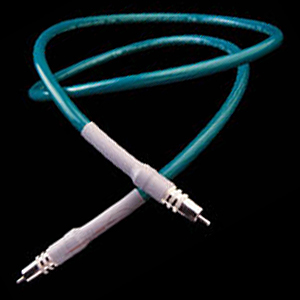
-
Diameter: .415 inches
-
Dielectric: Teflon, air
-
RCA capacitance (pf/ft): 26.4
-
XLR capacitance (pf/ft): 16
-
Number of discrete vonductors: 136
-
Cable awg: 17.5
-
Shield type: Double
-
Conductor type: Golden ratio, Constant Q, Crossfield Construction, pure copper and Litz wire
Cardas Cross speaker cable
Retail: $544 a 1.5 meter
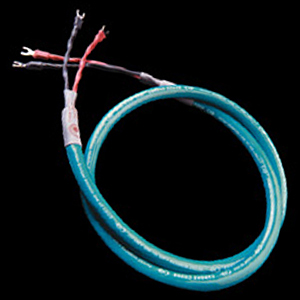
-
Diameter: .585 inches
-
Dielectric: Teflon, air
-
Inductance (uh/ft/loop): .11
-
Capacitance (pf/ft): 34
-
Number of discrete conductors: 238
-
Cable awg: 10
-
Internal bi/tri-wire options: Bi
-
Conductor type: Golden ratio, Constant Q, Crossfield Construction, pure copper and Litz wire
Cardas Golden Cross interconnect
Retail: $900 a meter
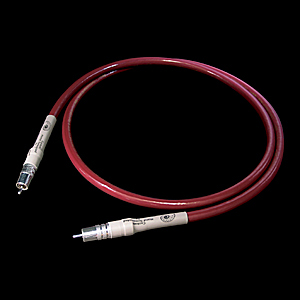
-
Diameter: .415 inches
-
Dielectric: Teflon, air
-
RCA capacitance (pf/ft): 25.5
-
XLR capacitance (pf/ft): 15.5
-
Number of discrete conductors: 174
-
Cable awg: 16.6
-
Shield type: Double
-
Conductor type: Golden ratio, Constant Q, Crossfield Construction, pure copper and Litz wire
Cardas Golden Cross speaker cable
Retail: $1428 a 1.5 meter (single run)
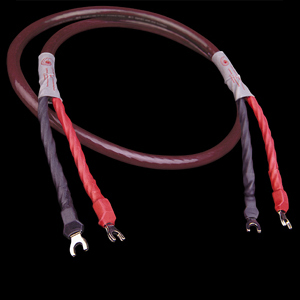
-
Diameter: .600 inches
-
Dielectric: Teflon, air
-
Inductance (uh/ft/loop): .0368
-
Capacitance (pf/ft): 154
-
Number of discrete conductors: 752
-
Cable awg: 5.5
-
Internal bi/tri-Wire Options: Bi
-
Conductor type: Golden ratio, Constant Q, Crossfield Construction, pure copper and Litz wire
Cardas Lightning 15 Digital Cable
-
Diameter: .481 inches
-
Dielectric: Teflon, air
-
Impedance: 75 ohm (+.5, -0)
-
Number of discrete conductors: 57
-
Cable awg: 18.5
-
Shield type: Double
-
Conductor type: Golden Ratio, Constant Q, Crossfield, pure copper and Litz wire
Cardas
web address: www.cardas.com
